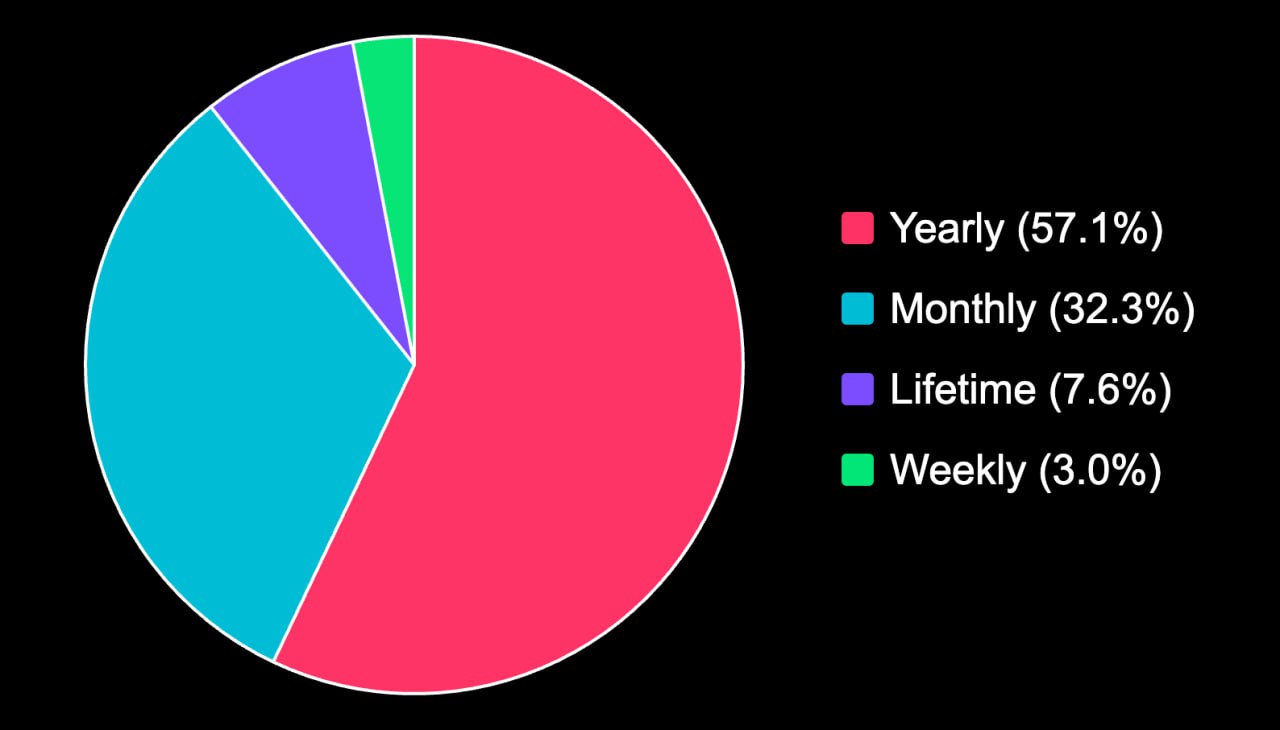Subscription Models Compared: Monthly, Annual, Lifetime & Weekly Plans
Introduction
Choosing the right subscription model can make or break a SaaS business. Whether it's monthly, annual, lifetime, or weekly billing, each approach has unique benefits and challenges. The key is understanding customer psychology, retention patterns, and cash flow implications to maximize revenue while reducing churn.
This article provides a detailed comparison of different pricing models, highlighting how to optimize each for sustainable growth. Let's take a look at what data we accumulated across many partner and client businesses:

1. Monthly Subscriptions: Flexibility vs. High Churn
💡 Why Monthly Plans Work
- Lower upfront cost makes it easier for new users to try the service.
- Ideal for price-sensitive customers who prefer flexibility.
- Works well for products with frequent feature updates and continuous value delivery.
⚠️ Challenges of Monthly Billing
- Higher churn rates—customers can cancel at any time.
- Less predictable revenue, making scaling harder.
- More customer support costs due to frequent billing issues.
✅ Best Practices for Monthly Plans
- Offer a free trial to reduce risk perception.
- Use reminder emails before renewal to lower involuntary churn.
- Provide an easy upgrade path to annual subscriptions.
Stat: Companies with only monthly plans see an average churn rate of 40% per year compared to annual plans.
2. Annual Subscriptions: Maximizing LTV & Reducing Churn
💰 Why Annual Plans Are Better for Growth
1️⃣ Higher Customer Lifetime Value (LTV): Customers commit for 12 months upfront.
2️⃣ Lower Churn: Annual subscribers are less likely to cancel compared to monthly users.
3️⃣ Stronger Cash Flow: Startups receive the full payment upfront, accelerating reinvestment in growth.
4️⃣ Lower Customer Acquisition Costs (CAC): Since annual subscribers churn less, CAC decreases over time.
🏆 Who Benefits Most from Annual Plans?
- SaaS tools with steady value delivery over time (e.g., productivity, business automation).
- Businesses targeting Western markets, where long-term subscriptions are common.
- Companies with high CAC, needing long-term retention to justify ad spend.
🔥 How to Increase Annual Plan Adoption
✅ Highlight cost savings (e.g., “Save 30% with an annual plan!”).
✅ Make the annual plan the default selection in the pricing UI.
✅ Use limited-time discounts to drive conversions.
✅ Bundle additional perks (e.g., priority support, extra features).
Case Study: Dropbox increased annual plan adoption by 42% after optimizing its pricing page to emphasize long-term savings.
3. Lifetime Plans: Instant Revenue, Long-Term Risk
🏗️ Why Some Startups Offer Lifetime Deals
- Quick cash influx—great for pre-launch funding.
- Appeals to early adopters who want a one-time purchase.
- Eliminates churn concerns (but at the cost of future revenue).
⚠️ Challenges of Lifetime Plans
- Unsustainable revenue model—if too many customers buy lifetime access, future income stagnates.
- Long-term support costs increase without additional revenue.
- Harder to justify ongoing development when users have already paid upfront.
✅ Best Use Cases for Lifetime Plans
- Pre-launch funding: Helps bootstrap startups without VC backing.
- Limited-time offers: Creates FOMO (fear of missing out) for early adopters.
- One-off tools: Works well for niche, non-subscription-based software.
Tip: If offering lifetime plans, ensure scalable unit economics so that the upfront revenue covers long-term costs.
4. Weekly Subscriptions: High Churn, Short-Term Gains
📉 Why Weekly Subscriptions Are a Gamble
- Typically used in mobile apps for impulse-driven purchases.
- Users sign up at high rates but churn just as fast.
- Works well for apps that deliver instant value but struggle with long-term retention.
🔄 Who Should Consider Weekly Plans?
✅ Entertainment & fitness apps (e.g., meditation, workout plans).
✅ Short-term tools (e.g., AI-generated content services).
✅ Seasonal demand businesses (e.g., tax-filing software during tax season).
Warning: Weekly subscriptions require constant user acquisition to maintain revenue, making them costly to sustain long-term.
Comparison Table: Choosing the Right Subscription Model
| Subscription Type | Pros | Cons | Best For |
|---|---|---|---|
| Monthly | Easy entry, flexible | High churn, unpredictable revenue | Price-sensitive users, SaaS tools with frequent updates |
| Annual | Higher LTV, lower churn, stable cash flow | Requires upfront commitment | B2B SaaS, tools with continuous value, companies scaling revenue |
| Lifetime | Quick revenue boost, no churn | Long-term support costs, no recurring revenue | Early-stage funding, non-subscription software |
| Weekly | High impulse signups, fast revenue | Extreme churn, constant acquisition needed | Mobile apps, short-term utility tools |
Conclusion
The subscription model isn’t just about getting signups—it’s about maximizing profitability and retention. Choosing between monthly, annual, lifetime, or weekly depends on your business type, target audience, and long-term sustainability goals.
🔥 Key Takeaways:
- Monthly plans attract more users but have higher churn.
- Annual subscriptions improve LTV and retention while securing upfront revenue.
- Lifetime deals can generate quick cash flow but should be limited.
- Weekly plans work for mobile apps but require constant acquisition efforts.
Want expert help optimizing your subscription strategy for maximum growth?
agency.pizza specializes in SaaS pricing psychology, retention strategies, and UI/UX optimization.
Let’s scale your revenue efficiently!



